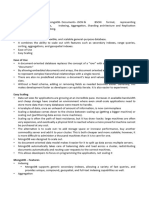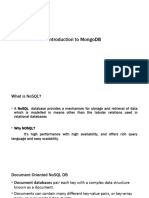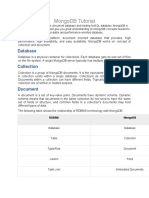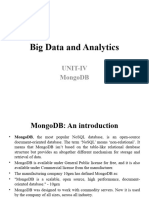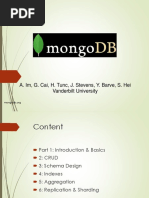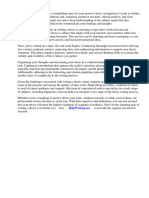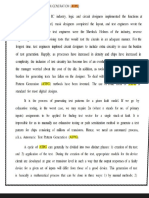Data Modeling with
MongoDB
01 Introduction to MongoDB
02 Schema Design Principles
03 Data Relationships in MongoDB
CONTENTS
04 Indexing for Performance
05 5
Aggregation Framework in MongoDB
06 6
Best Practices for Data Modeling
Introduction to
MongoDB
Overview of MongoDB
Definition of NoSQL
NoSQL databases are designed to
provide flexible and scalable storage
solutions. They manage data in ways
that differ from traditional relational
databases, enabling diverse data
structures and types, which suits varied
JSON-like Documents
data requirements across applications.
MongoDB utilizes JSON-like documents, allowing
for the incorporation of complex data types. This
format supports nested documents and arrays,
making it easy to represent relationships and
structured data within a single document.
Flexibility in Schema
MongoDB’s flexible schema enables collections to contain
documents with varying fields and data types. This
adaptability facilitates rapid development and iteration,
essential for applications dealing with unstructured or
Importance of Data Modeling
Maintainability
Effective data modeling simplifies maintenance and
evolution of applications. Clear organization of data
structures leads to easier updates, troubleshooting,
and integration of new functionalities over time.
Scalability
A well-thought-out data model contributes to the
scalability of applications, promoting ease of
horizontal scaling. This allows systems to
accommodate increased loads effectively without
compromising performance.
Efficient Data Retrieval
Proper data modeling ensures that data can be
accessed quickly and efficiently. By structuring data
according to query patterns, applications can
reduce latency and improve performance in data
retrieval operations.
Schema Design
Principles
Understanding Flexible Schema
No Strict Schema Enforcement
MongoDB does not impose rigid schema 01.
requirements, allowing developers to modify
schemas dynamically as application needs
mature. This fosters innovation and reduces the
overhead of predefined data structures.
Different Document Structures
Documents within a single collection can have varying fields
and structure, allowing for varied data representations. This 02.
is particularly useful for applications needing to adjust to
changing user requirements or feature sets.
Embedding vs. Referencing
Benefits of Embedding
By embedding related data within a
single document, applications can
minimize the number of database
operations for read requests. This
approach significantly boosts read
performance, particularly for read-heavy
applications.
When to Use Referencing
Referencing remains advantageous for
large datasets or frequently updated
records, as it helps avoid data
redundancy and maintain data integrity. It
allows developers to link documents
without duplicating data, enhancing
overall system performance.
Data Relationships
in MongoDB
Types of Data Relationships
One-to-One Relationships Many-to-Many Relationships
One-to-one relationships in MongoDB can Many-to-many relationships can be
be efficiently represented by embedding managed using an intermediate collection,
data within a single document, such as which links the documents involved. This
associating a user profile with settings, not only avoids data duplication but also
ensuring data coherence and simplifying provides an effective way to query related
access. data across collections.
One-to-Many Relationships
For one-to-many relationships, embedding can be
preferred for smaller datasets. However, referencing
is often utilized in scenarios where the “many” side
of the relationship frequently changes, thus
minimizing the need for document updates.
Strategies for Managing Relationships
Referencing for Larger Datasets
For larger, dynamic datasets, referencing
helps manage relationships while keeping
documents manageable. This approach is
Embedding for Small Datasets essential when the involved data
undergoes frequent updates or is subject
Embedding is particularly useful for small, to scaling.
static datasets where access speed is
critical. It reduces the number of reads on
the database, leading to improved
performance for frequently accessed
data.
Indexing for Performance
Importance of Indexes
Speeding Up Data Retrieval
Indexes are crucial for enhancing the
efficiency of data queries, significantly
reducing the time taken to locate
information within extensive datasets. They
create pointers to data, facilitating faster
data navigation.
Common Types of Indexes
01
Single-field Index
A single-field index allows for quick searches on one
specified field, serving as a fundamental approach for query
optimization in MongoDB applications.
Compound Index
02
Compound indexes consist of multiple fields, enabling more
complex queries to execute quickly. This type of index is
ideal for queries that filter results based on multiple
parameters.
Text Index
03
03
Text indexes support full-text search capabilities, allowing for
efficient searching of string content in documents. This type
of indexing is essential for applications that require
comprehensive search functionality.
Aggregation Framework
in MongoDB
Overview of Aggregation Tools
Data Processing Capabilities
MongoDB's aggregation framework
provides advanced tools for processing
and transforming data efficiently. It
supports operations like filtering, grouping,
and sorting, allowing for comprehensive
data analysis and reporting.
Key Stages of Aggregation
$match Stage $sort Stage
The $match stage is used to filter The $sort stage enables
documents based on certain ordering of data based on
criteria. This stage enhances specified fields. This operation
performance by limiting the is crucial for organizing query
number of documents that results to enhance readability
proceed to the subsequent and facilitate further processing.
processing stages, thus optimizing
$group
overall Stage
query efficiency. $project Stage
$group allows developers to The $project stage reshapes the
aggregate data based on specific documents returned by the
fields. By forming groups of aggregation pipeline, allowing
documents, it enables tasks such developers to include or exclude
as calculating sums, averages, specific fields. This is useful for
and other statistical operations on optimizing the data presented in
grouped data. final query results.
Analyzing Query Patterns
Designing Based on Queries
Understanding how data will be queried
enables architects to design more effective
schemas. By focusing on query patterns,
models can be optimized for the most
common access paths, improving overall
application performance.
Optimizing Storage
Appropriate Data Types
Using suitable data types in MongoDB not only conserves space but also
enhances query performance. Choosing the right data representation is
fundamental for achieving efficient data storage and processing.
Avoiding Data Duplication
Minimizing data duplication is vital for maintaining data integrity and reducing
storage costs. Effective schema design, using referencing techniques, can
help ensure that data remains consistent and manageable.
Balancing Read and Write Performance
Choosing Between Embedding and Referencing
The choice between embedding and referencing should be influenced by
application needs for read versus write operations. Developers must evaluate
usage patterns to select the most effective data modeling strategy for their
application.
Utilizing Indexes Effectively
Index Creation on Frequently
Queried Fields
Creating indexes on fields that are queried
often is essential for maximizing performance.
By anticipating access patterns and
strategically applying indexes, applications can
maintain high performance in data retrieval
operations.
Thank you for listening.














